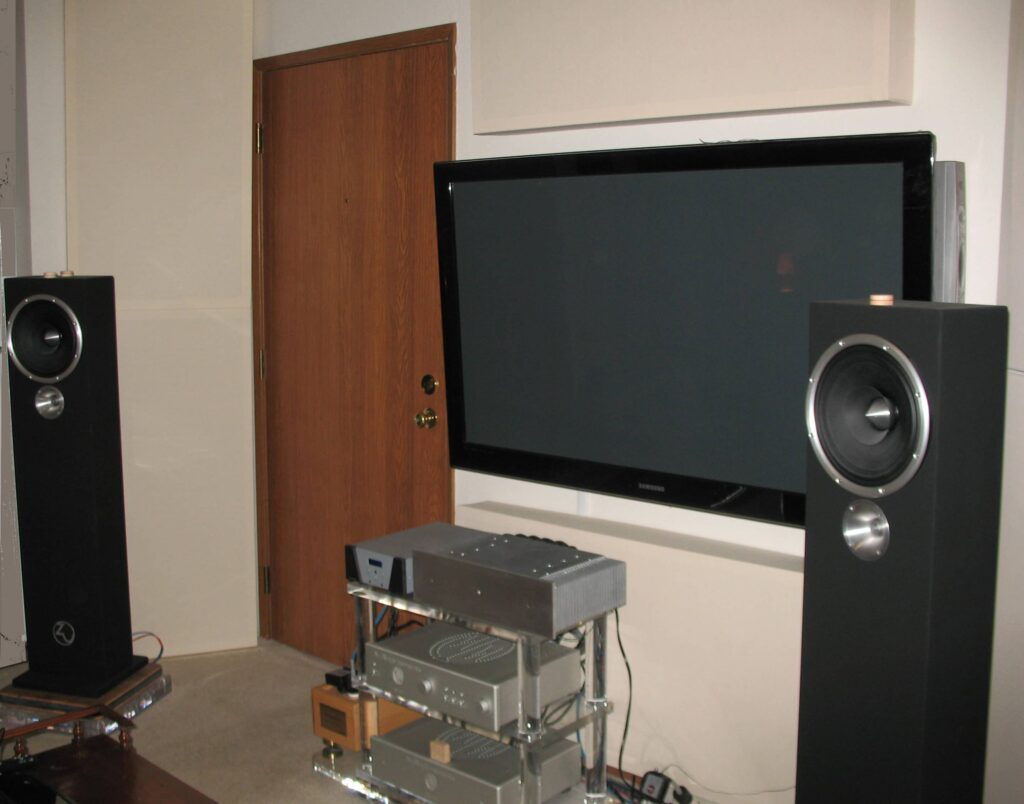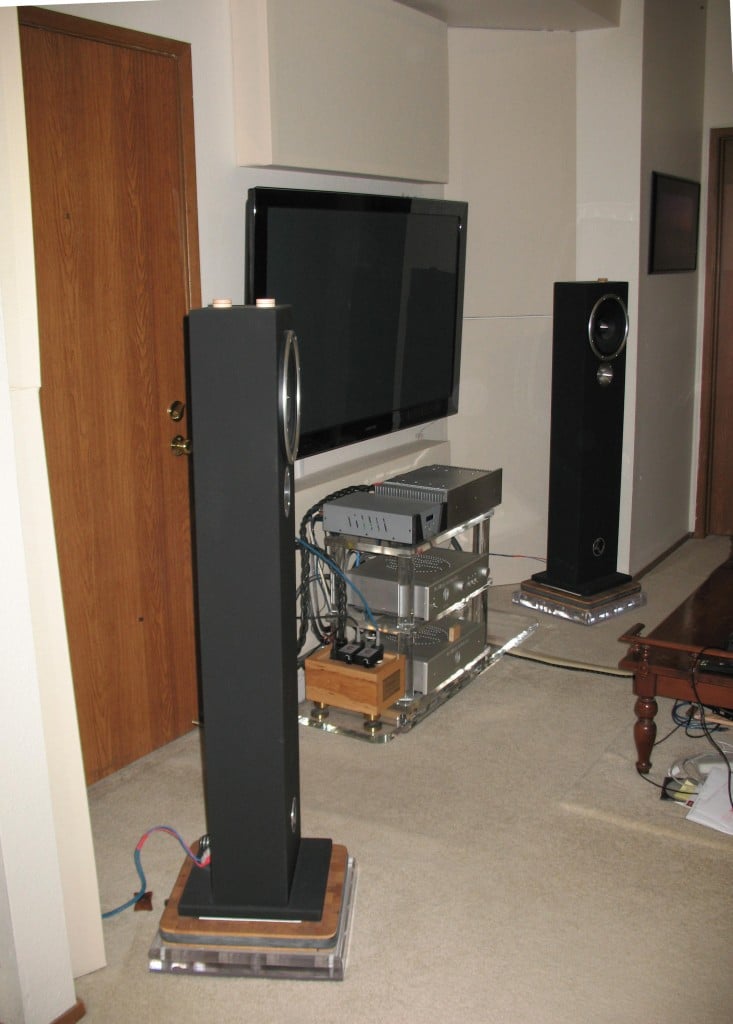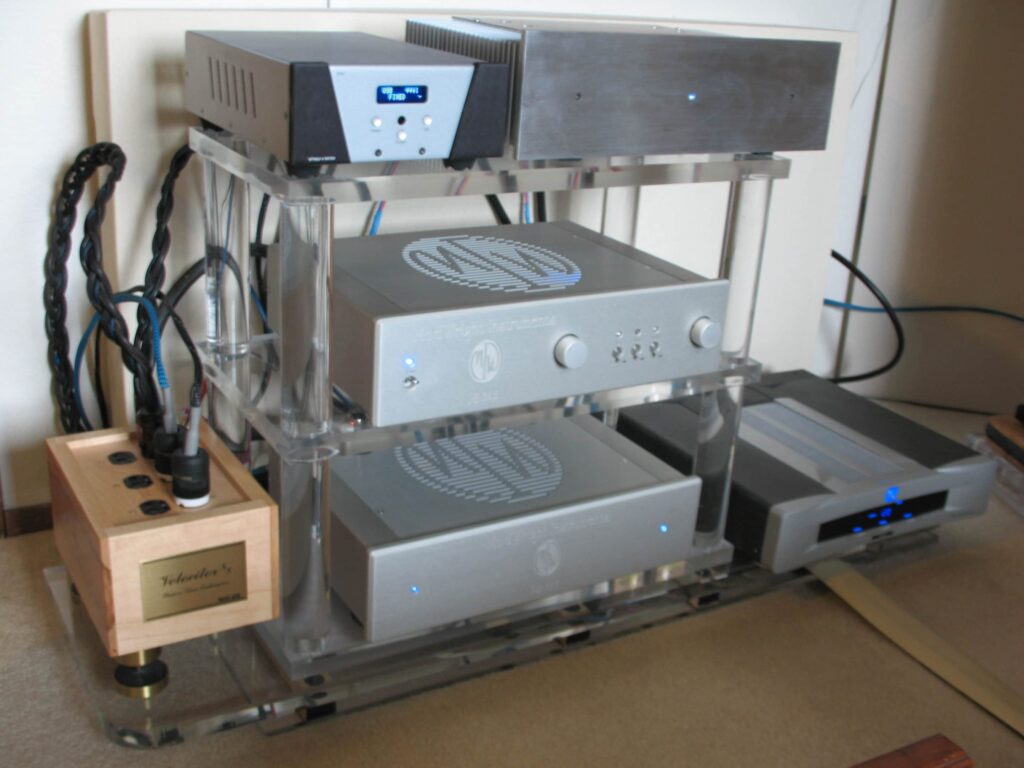Things were sounding pretty good in 2009 for JaguarAudio.com, but more radical changes were in store for our system as 2010 unfolded. The Zu Druids had great synergy with the Red Wine Isabella DAC/Pre and 30.2 power amp. One ASI Liveline interconnect between the two components and Liveline speaker cables brought out a lot of detail from within the thick, full Red Wine sound. Everything was set up well and dialed in and I was getting really good sound. Yet, I couldn’t manage to leave well enough alone. After a mere few months of having the Red Wine humming along I made a move that would take almost two years to get right.
I had read about the First Watt F5 amplifier in a 2008 6moons review. Srajan described the character of the amp as ultra-high resolution, with the ability to see miles deep into the music. He compared the sound of the F5 to the traditional 300B sound, a dense and lush sound you can feel in your body, while the F5 has a linear, defined and spatial sound you can picture in your mind. I found this review very compelling, without appreciating the challenge the F5 would present.
https://www.6moons.com/audioreviews/firstwatt7/f5.html
I ran across a homemade F5 for $400. At this low price, my plan was to just move the F5 in and out of the system with the 30.2 for a change of pace, but I quickly discovered that wasn’t going to work. The F5 didn’t gel with the Isabella preamp and I no longer had a power conditioner or even an audio power cable for it. Somehow I still heard through to the ultimate potential of the F5, so I made a commitment to move fully into the F5. This was no small commitment…I would have to sell the Red Wine components and buy a new preamp and DAC; no longer having battery power meant I needed a power conditioner and several power cables. Had I known where this was going I would have been content to enjoy the Red Wine gear for a while longer. My $400 dalliance would turn into a $25,000 investment two years later.
The F5’s extremely low noise and low distortion brings speakers to life at very low volume…an essential ability for condo/apartment dwellers. However, compared to the First Watt F3 I owned a few years prior, the F5 is a very finicky thoroughbred. Tube amps generally have a full, sweet-sounding character that comes from what’s called Second Harmonic Distortion, which is distortion in tune with certain frequencies, so it’s often not recognized as distortion…it’s musical distortion (if that’s what you’re going for in your sound). With the F3 you get very a palatable and sweet tube-like sound and a reasonable amount of detail; it works well with a lot of different gear and isn’t very demanding. The F5 on the other hand has much lower THD (Total Harmonic Distortion). Rather than sweeten your sound, the F5 adds no coloration, but lowers the noise floor so far that it provides an incredible amount of detail and separation of notes.
For the F5 to really show its colors it requires you feed it with the most robust and pure power possible. We live about 12 floors up in a building in Downtown Seattle, with a restaurant and a bar in the lobby and many other tenants to compete with for power. You won’t get pristine power straight out of the wall in a place like this. I went with the Walker Audio Velocitor to handle my power conditioning. The Velocitor is fast (thus the name) and has great extension, so it works well with the F5, but it doesn’t do much to filter the power. The balanced power type conditioner I had used before sounded lethargic with the Velocitor, so I went with the PS Audio Power Plant Premier (out of the wall and into the Velocitor), which was a good combo. By the start of 2012 I had corrected our power to the point that I was able to get very good sound with the F5, though I was still struggling with uneven sound during times other than the pristine hours after midnight.
Since buying the Druids I had been struggling to manage the additional bass, which wasn’t present with the Abbys. I began adding the GIK acoustic panels shown in the pictures below. I started out with two sets of the rectangular panels in the corners. Eventually I bought a pair of the corner trap model for the right, but they wouldn’t fit in the left corner, so I left the rectangular panels there and put some plastic bags stuffed with fiberglass insulation behind them. Not only will bass vibration drain through the spikes and into the floor, but much of it can be airborne and drain into the walls and structure, but it’s inhibited by the panels. The corner treatments do a lot to capture the standing bass waves and overall vibration coming from the bottom-ported bass in the Druid.
The price of flat-screen TVs had come down substantially by 2010, so I made the move from the 51” rear-projection to a 58” plasma. This really opened up the area between the speakers, but I lost my shelf above the TV. It was around this time I learned that cast acrylic was often used in audio applications, due to its low-resonance property. There are plenty of videos on the Internet about working with acrylic, so rather than spend $10k on an audio shelf, I built the shelf in the picture (see the article on this blog entitled “You Can Build a High-Performance Audio Shelf (for $300)”). The shelf sits on top of Sorbothane devices to absorb vibration coming up from the floor and through the air. Sorbothane is an amazing material that just absorbs vibration out of existence. Read my blog post about how to use Sorbothane properly and check out the Sorbothane footers in our store.
When I started with computer audio I was using my new Gateway laptop, but I soon realized I wasn’t going to achieve the best sound quality with the laptop. Check out my post on this blog entitled “Jaguar Music Servers“ for the details on the direction I went with the computer. I’m using a Wyred 4 Sound DAC 2 right now. With the DAC I could have tried to balance the character of the F5 or accentuate it; I chose the latter.
This is where we are in mid-2012 and the next 18-24 months look like they will entail changes just as dramatic as the past few years.



